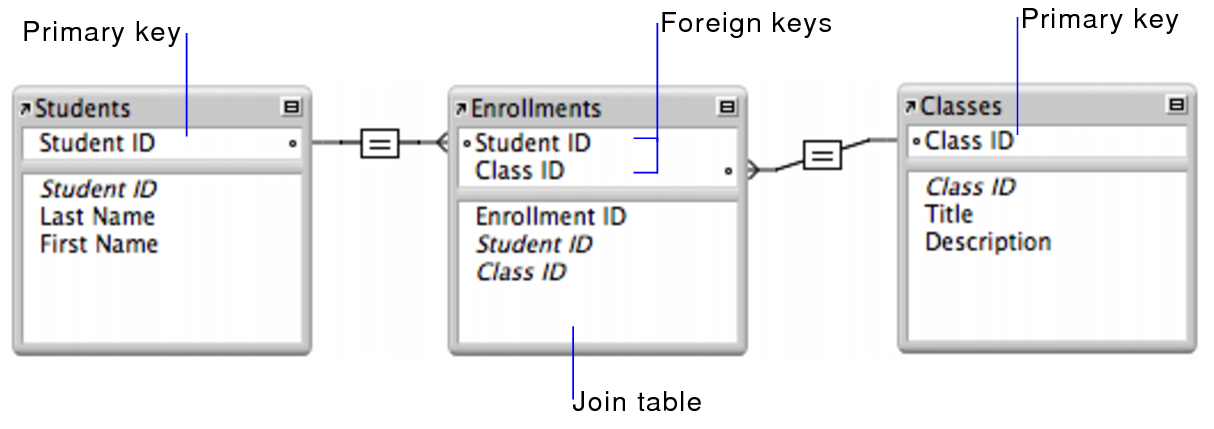database---many to many relationships(多对多关系型数据库)
Many to many Relationships
A many-to-many relationship occurs when multiple records in a table are associated with multiple records in another table. For example, a many-to-many relationship exists between customers and products: customers can purchase various products, and products can be purchased by many customers.
Relational database systems usually don't allow you to implement a direct many-to-many relationship between two tables. Consider the example of keeping track of invoices. If there were many invoices with the same invoice number and one of your customers inquired about that invoice number, you wouldn’t know which number they were referring to. This is one reason for assigning a unique value to each invoice.
To avoid this problem, you can break the many-to-many relationship into two one-to-many relationships by using a third table, called a join table. Each record in a join table includes a match field that contains the value of the primary keys of the two tables it joins. (In the join table, these match fields are foreign keys.) These foreign key fields are populated with data as records in the join table are created from either table it joins.
A typical example of a many-to many relationship is one between students and classes. A student can register for many classes, and a class can include many students.
The following example includes a Students table, which contains a record for each student, and a Classes table, which contains a record for each class. A join table, Enrollments, creates two one-to-many relationships—one between each of the two tables.

The primary key Student ID uniquely identifies each student in the Students table. The primary key Class ID uniquely identifies each class in the Classes table. The Enrollments table contains the foreign keys Student ID and Class ID.
To set up a join table for a many-to-many relationship:
Using the example above, create a table named Enrollments. This will be the join table.
In the Enrollments table, create a Student ID field and a Class ID field.
Join tables typically hold fields that might not make sense to have in any other table. You can add fields to the Enrollments table, such as a Date field to keep track of when someone started a class, and a Cost field to track how much a student paid to take a class.
- Create a relationship between the two Student ID fields in the tables. Then create a relationship between the two Class ID fields in the tables.
Using this design, if a student registers for three classes, that student will have one record in the Students table and three records in the Enrollments table—one record for each class the student enrolled in.
Notes
- Join tables can access fields and data across tables without having to create a separate relationship. For example, to display a list of all the classes a student enrolled in, create a portal on a layout based on the Students table. Design the portal to show related records from the Classes table. Then add the appropriate fields from Classes to the portal. As you browse through records in the Students layout, the portal displays all the classes a particular student is enrolled in.
database---many to many relationships(多对多关系型数据库)的更多相关文章
- Node的关系型数据库ORM库:bookshelf
NodeJs 关系数据库ORM库:Bookshelf.js bookshelf.js是基于knex的一个关系型数据库的ORM库.简单易用,内置了Promise的支持.这里主要罗列一些使用的例子,例子就 ...
- 关系型数据库之Mysql
简介 主要知识点包括:能够与mysql建立连接,创建数据库.表,分别从图形界面与脚本界面两个方面讲解 相关的知识点包括:E-R关系模型,数据库的3范式,mysql中数据字段的类型,字段约束 数据库的操 ...
- Oracle之关系型数据库
什么是关系型数据库? (1)关系型数据库是依据关系模型来创建的数据库. (2)所谓关系模型就是"一对一.一对多.多对多"等关系模型,关系模型就是指二维表格模型,因而一个关系型数据库 ...
- MongoDB学习笔记(二:入门环境配置及与关系型数据库区别总结)
一.下载及安装MongoDB MongoDB下载官网链接:http://www.mongodb.org/downloads 具体安装步骤教程:http://www.shouce.ren/api/vie ...
- Sqoop2入门之导入关系型数据库数据到HDFS上(sqoop2-1.99.4版本)
sqoop2-1.99.4和sqoop2-1.99.3版本操作略有不同:新版本中使用link代替了老版本的connection,其他使用类似. sqoop2-1.99.4环境搭建参见:Sqoop2环境 ...
- Google的分布式关系型数据库F1和Spanner
F1是Google开发的分布式关系型数据库,主要服务于Google的广告系统.Google的广告系统以前使用MySQL,广告系统的用户经常需要使用复杂的query和join操作,这就需要设计shard ...
- 大数据时代的数据存储,非关系型数据库MongoDB
在过去的很长一段时间中,关系型数据库(Relational Database Management System)一直是最主流的数据库解决方案,他运用真实世界中事物与关系来解释数据库中抽象的数据架构. ...
- 非关系型数据库SequoiaDB虚拟机下应用初探
SequoiaDB是广州巨杉软件有限公司开发的一款新型分布式非关系型数据库.可应用于linux操作系统下.在虚拟机下试用了一下(操作系统Ubuntu),感觉不错,操控简单易上手,在此分享一下心得. 下 ...
- ORMBase对象/关系型数据库映射在MVC中的应用
ORM这个字眼在我们操作数据库的时候,是我们使用频率最高的.它到底是个什么东西呢,我们先来看看一些对它的含义解释. 对象/关系数据库映射(object/relational mapping(ORM)) ...
随机推荐
- File upload in ASP.NET Core web API
参考1:File upload in ASP.NET Core web API https://www.janaks.com.np/file-upload-asp-net-core-web-api/ ...
- [题解](数学)BZOJ_1257_余数求和
来源:https://blog.csdn.net/loi_dqs/article/details/50522975 并不知道为什么是sqrt(n)的段数......书上写的看不懂...... 但是这个 ...
- python使用C扩展
CPython还为开发者实现了一个有趣的特性,使用Python可以轻松调用C代码 开发者有三种方法可以在自己的Python代码中来调用C编写的函数-ctypes,SWIG,Python/C API.每 ...
- django (一) 环境的配置及Django文件简介
1, 创建虚拟环境(virtualenv 和virtualenvwrapper) 1.1, virtualenv的概述 virtualenv是用来创建Python的虚拟环境的库,虚拟环境能够独立于真实 ...
- python入门之lambda表达式、内置函数
lambda 简单的函数就可以用lambda表达式 格式: abc = lambda a1,a2:a1+a2 其中,传参是a1和a2,返回值是a1+a2 内置函数 abs(a) #取绝对值 all(a ...
- 云服务中IaaS、PaaS、SaaS的区别
越来越多的软件,开始采用云服务. 云服务只是一个统称,可以分成三大类. IaaS:基础设施服务,Infrastructure-as-a-service PaaS:平台服务,Platform-as-a- ...
- hdu4027Can you answer these queries?(线段树)
链接 算是裸线段树了,因为没个数最多开63次 ,开到不能再看就标记.查询时,如果某段区间被标记直接返回结果,否则继续向儿子节点更新. 注意用——int64 注意L会大于R 这点我很纠结..您出题人故意 ...
- 用Excel生成Sql
用Excel生成Sql: 以如图为例:点击一行数据的后面一个单元格,在上面的fx部分输入=,以等号开头证明这是一个公式.在等号的后面写上想要添加的数据,书写规范是这样:'"&A2&a ...
- 总结React关于require的问题
我需要实现的是当登录页面传过来的sex值为1则性别一栏的图片修改为boy.png如果为0性别图片则显示为girl.png‘ 最开始是这么写的为了让他成为变量 所以不行ok我们回到React的生命周期函 ...
- html5.0学习记录(一)——可拖动视频播放器
最近自己在重新学习html5新特性,了解到有视频标签和拖动标签,于是自己用这两个特性写了一个小demo,主要功能就是可以通过拖动视频来直接播放.效果图如下: 页面使用了<video>标签和 ...
